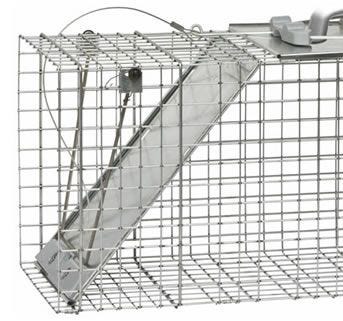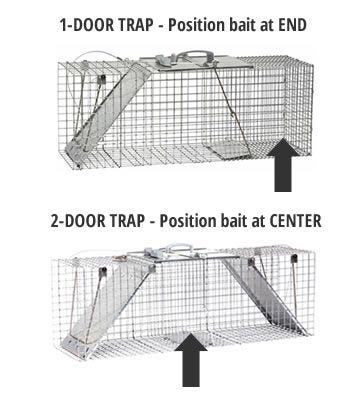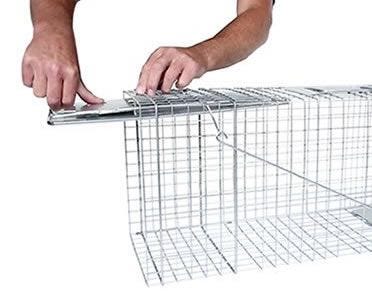





Opossums
How to Trap an Opossum
If an opossum finds its way inside your home, barn, shed or poultry house, the best way to remove it is with a live opossum trap. Below, learn information about opossum removal, including preparing your trap, proper handling and more.
1 Select an Opossum Trap

Choose a live opossum trap that's about 30 - 40 inches in length and 12 inches in height, giving the animal enough room to fully enter the trap. Most traps come in either 1 or 2-door models:
| 1-Door |
|
| 2-Door |
|

2 Determine Trap Placement
The best location for your opossum trap is inside or near it's den. If you are unable to identify where your opossum is living, place your trap in the spot where you have noticed the most damage or activity. Some placement guidelines to keep in mind include:
- If the opossum is living in your attic, shed or other similar structure, place the trap somewhere in the center of the room.
- If the animal is living somewhere less accessible like underneath your porch, under a crawlspace or inside a tree hollow, place the trap about 3-5 feet outside the entrance.
- Place your trap on an even, level surface.
- Keep the trap out of sunlight to avoid overheating of a trapped animal.

3 Bait Your Trap
Select an effective bait and position it properly:
- Bait your opossum trap with apples, fish or canned pet food.
- Position your bait in a way that will force the opossum to step on the trigger plate (see diagrams on the right).
- Make sure that no bait gets wedged between the trigger plate and the bottom of the trap - otherwise the doors will not close.
For more bait options and expert tips, read How To: Opossum Baits »

4 Set Your Trap
Opossums are nocturnal, so set your trap just before nightfall. Carefully open the trap doors(s) and set into place, following your trap's unique instructions to ensure that it's properly set.
TIP: For perfect setting every time, check out Easy Set® technology »

5 Check Trap Frequently
The longer an animal is neglected inside a live trap, the hungrier, thirstier, more anxious and more vulnerable to predators the animal will become. Check on your trap frequently so that an opossum is not trapped longer than necessary.
TIP: Opossums are nocturnal, and generally only come out at night. If the trap is still empty in the morning, close your trap to avoid catching unwanted daytime critters..

6 You've Caught an Opossum!
- Wear heavy gloves whenever handling the trap.
- Drape a cloth over the cage to keep the opossum calm. Place the trap on top of newspaper or inside a box top to catch any excrement when transporting the animal.
- If local laws permit, relocate the opossum to a forested area at least 5 miles from your property.

7 Remove Attractants
After removing your opossum, keep these scavengers out by eliminating sources of food and access to shelter. Havahart® suggests:
- cleaning up fallen birdseed, nuts, berries and fruit
- removing all uneaten pet food
- securing garbage cans with tight-fitting lids
- keeping any compost in secured, animal-proof containers
- repairing broken vents, screens, siding, roofing, etc.
- closing off all access to sheds, poultry houses, porches, etc.
- trimming all tree branches within 10 feet of your roof to keep opossums from accessing your attic
Expert Tips
- Before trapping an opossum, become familiar with the trapping and relocating laws in your area by contacting your local game commission.
- The best time of year to trap an opossum is late fall through early winter, before the breeding season.
- Stabilize your trap by placing a brick or weight on top. This will prevent animals from knocking the trap over, and will keep the trap from rattling when an opossum enters it.
- Using a small amount of bait, create a trail that leads the opossum inside. Be sure not to use too much bait to prevent the opossum from becoming satisfied before stepping inside the trap.
- An opossum may pretend to be dead - or "play possum" - when you try to release him from the cage. This is a normal defense mechanism that opossums use when threatened. Be patient and step away from the trap so the opossum can exit when it's ready.
